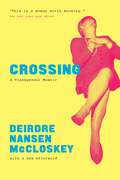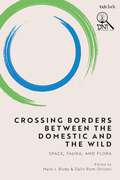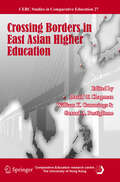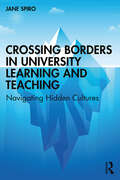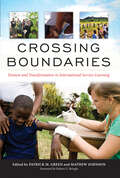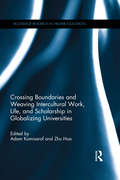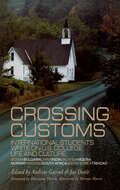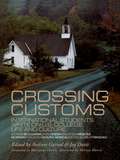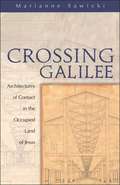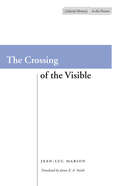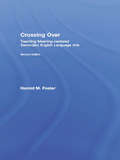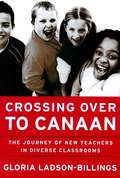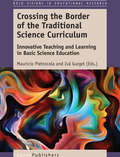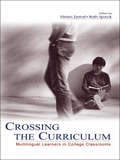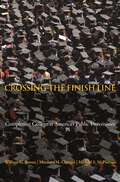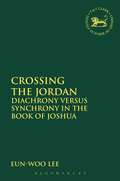- Table View
- List View
Crossing: A Transgender Memoir
by Deirdre N. McCloskeyA New York Times Book Review Notable Book of the Year “I visited womanhood and stayed. It was not for the pleasures, though I discovered many I had not imagined, and many pains too. But calculating pleasures and pains was not the point. The point was who I am.” Once a golden boy of conservative economics and a child of 1950s privilege, Deirdre McCloskey (formerly Donald) had wanted to change genders from the age of eleven. But it was a different time, one hostile to any sort of straying from the path—against gays, socialists, women with professions, men without hats, and so on—and certainly against gender transition. Finally, in 1995, at the age of fifty-three, it was time for McCloskey to cross the gender line. Crossing is the story of McCloskey’s dramatic and poignant transformation from Donald to Dee to Deirdre. She chronicles the physical procedures and emotional evolution required and the legal and cultural roadblocks she faced in her journey to womanhood. By turns searing and humorous, this is the unflinching, unforgettable story of her transformation—what she lost, what she gained, and the women who lifted her up along the way.
Crossing: A Transgender Memoir
by Deirdre N. McCloskeyA New York Times Book Review Notable Book of the Year “I visited womanhood and stayed. It was not for the pleasures, though I discovered many I had not imagined, and many pains too. But calculating pleasures and pains was not the point. The point was who I am.” Once a golden boy of conservative economics and a child of 1950s privilege, Deirdre McCloskey (formerly Donald) had wanted to change genders from the age of eleven. But it was a different time, one hostile to any sort of straying from the path—against gays, socialists, women with professions, men without hats, and so on—and certainly against gender transition. Finally, in 1995, at the age of fifty-three, it was time for McCloskey to cross the gender line. Crossing is the story of McCloskey’s dramatic and poignant transformation from Donald to Dee to Deirdre. She chronicles the physical procedures and emotional evolution required and the legal and cultural roadblocks she faced in her journey to womanhood. By turns searing and humorous, this is the unflinching, unforgettable story of her transformation—what she lost, what she gained, and the women who lifted her up along the way.
Crossing Borders between the Domestic and the Wild: Space, Fauna, and Flora
by Mark J. Boda Dalit Rom-ShiloniThe present volume searches for different biblical perceptions of the wild, paying particular attention to the significance of fluid boundaries between the domestic and the wild, and to the options of crossing borders between them. Drawing on space, fauna, and flora, scholars investigate the ways biblical authors present the wild and the domestic and their interactions. In its six chapters and two responses, Hebrew Bible scholars, an archaeobotanist, an archaeologist, a geographer, and iconographers join forces to discuss the wild and its portrayals in biblical literature.The discussions bring to light the entire spectrum of real, imagined, metaphorized, and conceptualized forms of the wild that appear in biblical sources, as also in the material culture and agriculture of ancient Israel, and to some extent observe the great gap between biblical observations and modern studies of geography and of mapping that marks the distinctions between “the wilderness” and “the sown.” The book is the first written product presented on two consecutive years (2019, 2020) at the SBL Annual Meetings in the Section: “Nature Imagery and Conceptions of Nature in the Bible.”
Crossing Borders between the Domestic and the Wild: Space, Fauna, and Flora
by Mark J. Boda and Dalit Rom-ShiloniThe present volume searches for different biblical perceptions of the wild, paying particular attention to the significance of fluid boundaries between the domestic and the wild, and to the options of crossing borders between them. Drawing on space, fauna, and flora, scholars investigate the ways biblical authors present the wild and the domestic and their interactions. In its six chapters and two responses, Hebrew Bible scholars, an archaeobotanist, an archaeologist, a geographer, and iconographers join forces to discuss the wild and its portrayals in biblical literature.The discussions bring to light the entire spectrum of real, imagined, metaphorized, and conceptualized forms of the wild that appear in biblical sources, as also in the material culture and agriculture of ancient Israel, and to some extent observe the great gap between biblical observations and modern studies of geography and of mapping that marks the distinctions between “the wilderness” and “the sown.” The book is the first written product presented on two consecutive years (2019, 2020) at the SBL Annual Meetings in the Section: “Nature Imagery and Conceptions of Nature in the Bible.”
Crossing Borders in East Asian Higher Education (CERC Studies in Comparative Education #27)
by David W. Chapman William K. Cummings Gerard A. PostiglioneThis book examines issues that have emerged as higher education systems and individual institutions across East Asia confront and adapt to the changing economic, social, and educational environments in which they now operate. The book’s focus is on how higher education systems learn from each other and on the ways in which they collaborate to address new challenges. The sub-theme that runs through this volume concerns the changing nature of cross-border sharing. In particular, the provision of technical assistance by more industrialized countries to lower and middle income countries has given way to collaborations that place the latter’s participating institutions on a more equal footing.
Crossing Borders in University Learning and Teaching: Navigating Hidden Cultures
by Jane SpiroUncovering aspects of university culture which are often hidden or misunderstood, this book brings together international perspectives, showing the matches and mismatches between experience and expectation, as both staff and student face new academic cultures. Drawing on the stories of students and members of staff in the higher education sector as starting points for analysis, this book considers aspects such as the dynamics and pragmatics of university settings, from tutorial to lecture; the assignment and multiple text types from reflective logs to essays; different interpretations of grades, grading and feedback. Topics are explored with examples from critical incidents and narratives in international contexts – both where staff or students cross cultures and borders, and where they are functioning within the university culture with which they are most familiar. Ideal both for those new to learning and teaching in higher education, and those seeking to refresh their practice, this must-read book uses case studies and narratives to illustrate key challenges academics and students face. With consideration given to learning across cultures, the narratives and topics lead to enquiries which the reader can ask and research for themselves to find helpful answers to explain their own university experiences.
Crossing Borders in University Learning and Teaching: Navigating Hidden Cultures
by Jane SpiroUncovering aspects of university culture which are often hidden or misunderstood, this book brings together international perspectives, showing the matches and mismatches between experience and expectation, as both staff and student face new academic cultures. Drawing on the stories of students and members of staff in the higher education sector as starting points for analysis, this book considers aspects such as the dynamics and pragmatics of university settings, from tutorial to lecture; the assignment and multiple text types from reflective logs to essays; different interpretations of grades, grading and feedback. Topics are explored with examples from critical incidents and narratives in international contexts – both where staff or students cross cultures and borders, and where they are functioning within the university culture with which they are most familiar. Ideal both for those new to learning and teaching in higher education, and those seeking to refresh their practice, this must-read book uses case studies and narratives to illustrate key challenges academics and students face. With consideration given to learning across cultures, the narratives and topics lead to enquiries which the reader can ask and research for themselves to find helpful answers to explain their own university experiences.
Crossing Boundaries: Tension and Transformation in International Service-Learning
by Patrick M. Green, Mathew Johnson, Robert G. BringleAre there better ways to address community challenges than expending funds on international service-learning?In attempting to wed learning and service, are we are exploiting the “other” for new, or recycled, aims?As these questions attest, of all types of service-learning, international service-learning (ISL) most starkly illuminates the tensions between the liberatory and oppressive potentials of practice.This book explores the ramifications of realizing a new age of service-learning that pushes beyond single episodic course-based projects to rebalance student learning and community outcome priorities, and provides insight into what it looks like in its execution. In describing eleven international programs designed to achieve reciprocal, sustained relationships in which learning is co-created, the contributors reveal their struggles to change the balance of power relationships and move to a more transformative practice. Common themes are the developmental nature of this work; the recognition that it takes multiple attempts, often over years, for an individual or an institution to get this work even nearly right; that resolving the challenges of unequal resources, power, and privilege can never be completely erased; and that attention has to be given to the micro-level details.What emerge are seven guiding principles that define the nature of partnerships in liberatory practice, and that apply to all forms of service learning. They must be: strategic--linked to the mission and expertise of the institution; long-term; multifaceted--allowing both partners to play a multiplicity of roles; developmental in building capacities; contextualized in historic and cultural understanding; fully reciprocal; and create the potential for community-driven change.In addressing the problematic nature of ISL, and of service-learning in general, this book interrogates whether its experiences create the necessary conditions for the formation of individual values, convictions, and action; and whether their pivotal teaching and learning moments are indeed replicable and transferable across individual, institutional and even cultural contexts. Its conclusions and insights will be of intense interest to administrators and practitioners alike.
Crossing Boundaries: Tension and Transformation in International Service-Learning
Are there better ways to address community challenges than expending funds on international service-learning?In attempting to wed learning and service, are we are exploiting the “other” for new, or recycled, aims?As these questions attest, of all types of service-learning, international service-learning (ISL) most starkly illuminates the tensions between the liberatory and oppressive potentials of practice.This book explores the ramifications of realizing a new age of service-learning that pushes beyond single episodic course-based projects to rebalance student learning and community outcome priorities, and provides insight into what it looks like in its execution. In describing eleven international programs designed to achieve reciprocal, sustained relationships in which learning is co-created, the contributors reveal their struggles to change the balance of power relationships and move to a more transformative practice. Common themes are the developmental nature of this work; the recognition that it takes multiple attempts, often over years, for an individual or an institution to get this work even nearly right; that resolving the challenges of unequal resources, power, and privilege can never be completely erased; and that attention has to be given to the micro-level details.What emerge are seven guiding principles that define the nature of partnerships in liberatory practice, and that apply to all forms of service learning. They must be: strategic--linked to the mission and expertise of the institution; long-term; multifaceted--allowing both partners to play a multiplicity of roles; developmental in building capacities; contextualized in historic and cultural understanding; fully reciprocal; and create the potential for community-driven change.In addressing the problematic nature of ISL, and of service-learning in general, this book interrogates whether its experiences create the necessary conditions for the formation of individual values, convictions, and action; and whether their pivotal teaching and learning moments are indeed replicable and transferable across individual, institutional and even cultural contexts. Its conclusions and insights will be of intense interest to administrators and practitioners alike.
Crossing Boundaries and Weaving Intercultural Work, Life, and Scholarship in Globalizing Universities (Routledge Research in Higher Education)
by Zhu Hua Adam KomisarofThis book generates a fresh, complex view of the process of globalization by examining how work, scholarship, and life inform each other among intercultural scholars as they navigate their interpersonal relationships and cross boundaries physically and metaphorically. Divided into three parts, the book examines: (1) the socio-psychological process of crossing boundaries constructed around nations and work organizations; (2) the negotiation of multiple aspects of identities; and (3) the role of language in intercultural encounters, in particular, adjustment taking place at linguistic and interactional levels. The authors reflect upon and give meaning and structure to their own intercultural experiences through theoretical frameworks and concepts—many of which they themselves have proposed and developed in their own research. They also provide invaluable advice for transnational scholars and those who aspire to work and live abroad to improve organizational participation and mutual intercultural engagement when working in a globalizing workplace. Researchers and practitioners of applied linguistics, communication studies, and higher education in many regions of the world will find this book an insightful resource.
Crossing Boundaries and Weaving Intercultural Work, Life, and Scholarship in Globalizing Universities (Routledge Research in Higher Education)
by Zhu Hua Adam KomisarofThis book generates a fresh, complex view of the process of globalization by examining how work, scholarship, and life inform each other among intercultural scholars as they navigate their interpersonal relationships and cross boundaries physically and metaphorically. Divided into three parts, the book examines: (1) the socio-psychological process of crossing boundaries constructed around nations and work organizations; (2) the negotiation of multiple aspects of identities; and (3) the role of language in intercultural encounters, in particular, adjustment taking place at linguistic and interactional levels. The authors reflect upon and give meaning and structure to their own intercultural experiences through theoretical frameworks and concepts—many of which they themselves have proposed and developed in their own research. They also provide invaluable advice for transnational scholars and those who aspire to work and live abroad to improve organizational participation and mutual intercultural engagement when working in a globalizing workplace. Researchers and practitioners of applied linguistics, communication studies, and higher education in many regions of the world will find this book an insightful resource.
Crossing Customs: International Students Write on U.S. College Life and Culture (RoutledgeFalmer Studies in Higher Education #Vol. 18)
by Jay Davis Andrew GarrodFirst Published in 1999. Routledge is an imprint of Taylor & Francis, an informa company.
Crossing Customs: International Students Write on U.S. College Life and Culture (RoutledgeFalmer Studies in Higher Education)
by Jay Davis Andrew GarrodFirst Published in 1999. Routledge is an imprint of Taylor & Francis, an informa company.
Crossing Galilee: Architectures of Contact in the Occupied Land of Jesus
by Marianne SawickiRecent books about Jesus and early Christianity can be divided into two kinds: those that examine the life and work of the historical Jesus prior to his death and those that reconstruct events between Jesus' death and the writings of the first Gospels. Sawicki's provocative book challenges the results of both kinds of research by using both archaeology and anthropology to situate Jesus clearly in his Galilean cultural context.Sawicki contests recent portraits of Jesus as a Mediterranean peasant, a Cynic sage, or the convener of a fellowship of equals. In addition, she calls into question readings of ancient Galilee that emphasize it as a society marked simply by economic stratification or by an "honor-shame" sociology. Rather, she discovers the Galilean Jesus' indigenous cultural idiom in its material structures for the negotiation of kinship, the management of labor, the distribution of commodities, and the construction of gender.Sawicki's book is the first to balance classical urban archaeology against the more recent archaeology of villages and of local and regional commerce. It frames current issues in Jesus research in terms that can guide both ongoing village excavations in Israel and responsible exegesis of the Gospels in church and academy.Marianne Sawicki is the author of Seeing the Lord: Resurrection and Early Christian Practices.For: Seminarians; graduate students; biblical archaeologists
Crossing The Line
by Tia FisherA powerful novel exploring how teenagers can be swept up into county lines. Erik's life has been falling apart ever since his dad died. Homework and being good at school stop feeling important when you're the new man of the house. When Erik's bad behaviour attracts the wrong crowd, he's sucked into a terrifying new world of drug dealing, trap houses and violence. Making money feels good but Erik soon learns that a small favour can become a huge debt. And when his sisters' lives are threatened, Erik will have to cross one more line to save them. Written in stunning verse, this is a poignant story about seeking safety and asking for help in times of crisis.
The Crossing of the Visible (Cultural Memory in the Present)
by Jean-Luc MarionPainting, according to Jean-Luc Marion, is a central topic of concern for philosophy, particularly phenomenology. For the question of painting is, at its heart, a question of visibility—of appearance. As such, the painting is a privileged case of the phenomenon; the painting becomes an index for investigating the conditions of appearance—or what Marion describes as "phenomenality" in general. In The Crossing of the Visible, Marion takes up just such a project. The natural outgrowth of his earlier reflections on icons, these four studies carefully consider the history of painting—from classical to contemporary—as a fund for phenomenological reflection on the conditions of (in)visibility. Ranging across artists from Raphael to Rothko, Caravaggio to Pollock, The Crossing of the Visible offers both a critique of contemporary accounts of the visual and a constructive alternative. According to Marion, the proper response to the "nihilism" of postmodernity is not iconoclasm, but rather a radically iconic account of the visual and the arts that opens them to the invisible.
Crossing Over: Teaching Meaning-centered Secondary English Language Arts
by Harold M. FosterThis text for secondary preservice and in-service English language arts teachers offers a rationale for meaning-centered English language arts teaching and practical strategies for application. Its goal is to provide readers with an understanding of the issues involved in English teaching and specific examples of how to apply this understanding to classrooms. Teaching strategies are presented through a series of stories depicting teachers from a variety of settings practicing their craft with secondary students. Features: *A solid introduction and interesting personal narratives introduce the issues and ideas involved in English language arts teaching. *Case studies based on actual teachers and students realistically illustrate methods that can be used in secondary English classes. *Lessons are described in sufficient detail to be converted to teaching models. *Multicultural emphasis prepares teachers for the contemporary classroom. *Chapters and sections incorporate the new literacies of TV, film, and computers in the English language arts class. *Pedagogical aids include end-of-chapter questions and activities, reproducible charts and worksheets; an updated listing of young adult novels; and annotated recommended readings. *An appendix on writing a personal narrative helps students develop as writers. New in the Second Edition: *Updates. All chapters, the bibliographies, and the references are thoroughly updated to reflect changes since the first edition was published. Chapters 1 and 2 have been totally rewritten. *Standards/Benchmarks. The IRA/NCTE Standards for the English Language Arts are incorporated into the text. Benchmarks and Performance Assessment Measures are included in all the pedagogical chapters to address proficiency concerns. A section on helping students prepare for state proficiency tests has been added. *Computers. More is included on the use of technology, both as a content to learn and as a process for learning. *New Sample Unit Plans. Sections based on the instructional stories offer examples to help readers prepare for teaching. *Literature response questions. These are now provided in Chapter 4 for use in journaling and discussions. *Glossary. A chapter on important terms and useful strategies for the English language arts classroom has been added.
Crossing Over: Teaching Meaning-centered Secondary English Language Arts
by Harold M. FosterThis text for secondary preservice and in-service English language arts teachers offers a rationale for meaning-centered English language arts teaching and practical strategies for application. Its goal is to provide readers with an understanding of the issues involved in English teaching and specific examples of how to apply this understanding to classrooms. Teaching strategies are presented through a series of stories depicting teachers from a variety of settings practicing their craft with secondary students. Features: *A solid introduction and interesting personal narratives introduce the issues and ideas involved in English language arts teaching. *Case studies based on actual teachers and students realistically illustrate methods that can be used in secondary English classes. *Lessons are described in sufficient detail to be converted to teaching models. *Multicultural emphasis prepares teachers for the contemporary classroom. *Chapters and sections incorporate the new literacies of TV, film, and computers in the English language arts class. *Pedagogical aids include end-of-chapter questions and activities, reproducible charts and worksheets; an updated listing of young adult novels; and annotated recommended readings. *An appendix on writing a personal narrative helps students develop as writers. New in the Second Edition: *Updates. All chapters, the bibliographies, and the references are thoroughly updated to reflect changes since the first edition was published. Chapters 1 and 2 have been totally rewritten. *Standards/Benchmarks. The IRA/NCTE Standards for the English Language Arts are incorporated into the text. Benchmarks and Performance Assessment Measures are included in all the pedagogical chapters to address proficiency concerns. A section on helping students prepare for state proficiency tests has been added. *Computers. More is included on the use of technology, both as a content to learn and as a process for learning. *New Sample Unit Plans. Sections based on the instructional stories offer examples to help readers prepare for teaching. *Literature response questions. These are now provided in Chapter 4 for use in journaling and discussions. *Glossary. A chapter on important terms and useful strategies for the English language arts classroom has been added.
Crossing Over to Canaan: The Journey of New Teachers in Diverse Classrooms
by Gloria Ladson-Billings"Gloria Ladson-Billings provides a perceptive and interestingaccount of what is needed to prepare novice teachers to besuccessful with all students in our multicultural society. Thisbook is must reading for all those entering the profession ofteaching today and for those who prepare them for this importantwork." --Ken Zeichner, associate dean and professor of curriculum andinstruction, School of Education, University ofWisconsin-Madison "The multiple voices in Gloria Ladson-Billings's book arecompelling, provocative, and insightful-they provide a powerful'insider' perspective on what it really means to learn to teach allchildren well." --Marilyn Cochran-Smith, professor of education and editor, Journalof Teacher Education, Boston College, School of Education "Ladson-Billings, one of the stellar researchers and mostpassionate advocates for social justice, has written yet anothermasterpiece. By weaving the novice teachers' voices, her personalteaching journey, and language rich in compelling research andinspiring metaphors, Ladson-Billings has documented how newteachers transform schools and teach poor children of color." --Jacquline Jordan Irvine, Candler Professor of Urban Education,Emory University, Division of Educational Studies "Masterful teacher and teacher-educator Gloria Ladson-Billings hasgiven us--in highly readable form--a brilliant vision of whatteacher education might become. In Crossing Over to Canaan we get aglimpse of how a carefully constructed teacher education programfocused on teaching for social justice can produce excellentteaching, even by young, middle-class teachers-in-training, indiverse educational settings." --Lisa D. Delpit, Benjamin E. Mays Professor of EducationalLeadership, Georgia State University The author of the best-selling book The Dreamkeepers shows howteachers can succeed in diverse classrooms. Educating teachers towork well in multicultural classrooms has become an all-importanteducational priority in today's schools. In Crossing Over toCanaan, Gloria Ladson-Billings details the real-life stories ofeight novice teachers participating in an innovative teachereducation program called Teach for Diversity. She details theirstruggles and triumphs as they confront challenges in the classroomand respond with innovative strategies that turn cultural strengthsinto academic assets. Through their experiences, Ladson-Billingsillustrates how good teachers can meet the challenges of teachingstudents from highly diverse backgrounds--and find a way to "crossover to Canaan." She offers a model of teaching that focuses onacademic achievement, cultural competence, and socio-politicalconsciousness. Drawing from her own experiences as a young African-Americanteacher working in Philadelphia, she successfully weaves togethernarrative, observation, and scholarship to create an inspirationaland practical book that will help teachers everywhere as they workto transcend labels and categories to support excellence among allstudents.
Crossing the Border of the Traditional Science Curriculum: Innovative Teaching and Learning in Basic Science Education (Bold Visions in Educational Research)
by Maurício Pietrocola Ivã GurgelNations worldwide consider education an important tool for economic and social development, and the use of innovative strategies to prepare students for the acquisition of knowledge and skills is currently considered the most effective strategy for nurturing engaged, informed learners. In the last decade especially, European countries have promoted a series of revisions to their curricula and in the ways teachers are trained to put these into practice. Updating curriculum contents, pedagogical facilities (for example, computers in schools), and teaching and learning strategies should be seen as a routine task, since social and pedagogical needs change over time. Nevertheless, educational institutions and actors (educational departments, schools, teachers, and even students) normally tend to be committed to traditional practices. As a result of this resistance to change within educational systems, implementing educational innovation is a big challenge. The authors of the present volume have been involved with curriculum development since 2003. This work is an opportunity to present the results of more than a decade of research into experimental, inventive approaches to science education. Most chapters concern innovative strategies for the teaching and learning of new contents, as well as methods for learning to teach them at the pre-university school level. The research is focused on understanding the pedagogical issues around the process of innovation, and the findings are grounded in analyses of the limits and possibilities of teachers’ and students’ practices in schools.
Crossing the Curriculum: Multilingual Learners in College Classrooms
by Vivian Zamel Ruth SpackAs college classrooms have become more linguistically diverse, the work of ESOL professionals has expanded to include research on the experiences of multilingual learners not only in ESOL courses but also in courses across the curriculum. At the same time that ESOL professionals are trying to understand the academic challenges that learners face beyond ESOL courses, faculty across the disciplines are trying to meet the challenge of teaching students of differing linguistic backgrounds. Crossing the Curriculum: Multilingual Learners in College Classrooms responds to these issues and concerns by capturing the complex and content-specific nature of students' and teachers' experiences and providing a nuanced understanding of how multilingual students' learning can be fostered and sustained. Crossing the Curriculum: Multilingual Learners in College Classrooms is unique in bringing together the perspectives of researchers, students, and teachers. These multiple lenses allow for a richly layered picture of how students and teachers actually experience college classrooms. Common themes and pedagogical principles resonate across the three distinct sections of the book:*Part One, "Investigating Students' Experiences Across the Curriculum: Through the Eyes of Classroom Researchers," consists of chapters written by ESOL and composition researchers who have investigated multilingual students' experiences in undergraduate courses across the curriculum.*Part Two, "Learning Across the Curriculum: Through Students' Eyes," consists of chapters written by two multilingual learners who chronicled their experiences as they crossed the curriculum over time.*Part Three, "Engaging Students in Learning: Through the Eyes of Faculty Across the Curriculum," consists of chapters written by faculty from several academic fields--Anthropology, Philosophy, Nursing, Literature, Sociology, and Asian American Studies--who discuss their own attempts to address the needs of multilingual learners in their classrooms.
Crossing the Curriculum: Multilingual Learners in College Classrooms
by Vivian Zamel Ruth SpackAs college classrooms have become more linguistically diverse, the work of ESOL professionals has expanded to include research on the experiences of multilingual learners not only in ESOL courses but also in courses across the curriculum. At the same time that ESOL professionals are trying to understand the academic challenges that learners face beyond ESOL courses, faculty across the disciplines are trying to meet the challenge of teaching students of differing linguistic backgrounds. Crossing the Curriculum: Multilingual Learners in College Classrooms responds to these issues and concerns by capturing the complex and content-specific nature of students' and teachers' experiences and providing a nuanced understanding of how multilingual students' learning can be fostered and sustained. Crossing the Curriculum: Multilingual Learners in College Classrooms is unique in bringing together the perspectives of researchers, students, and teachers. These multiple lenses allow for a richly layered picture of how students and teachers actually experience college classrooms. Common themes and pedagogical principles resonate across the three distinct sections of the book:*Part One, "Investigating Students' Experiences Across the Curriculum: Through the Eyes of Classroom Researchers," consists of chapters written by ESOL and composition researchers who have investigated multilingual students' experiences in undergraduate courses across the curriculum.*Part Two, "Learning Across the Curriculum: Through Students' Eyes," consists of chapters written by two multilingual learners who chronicled their experiences as they crossed the curriculum over time.*Part Three, "Engaging Students in Learning: Through the Eyes of Faculty Across the Curriculum," consists of chapters written by faculty from several academic fields--Anthropology, Philosophy, Nursing, Literature, Sociology, and Asian American Studies--who discuss their own attempts to address the needs of multilingual learners in their classrooms.
Crossing the Finish Line: Completing College at America's Public Universities
by William G. Bowen Matthew M. Chingos Michael S. McphersonThe United States has long been a model for accessible, affordable education, as exemplified by the country's public universities. And yet less than 60 percent of the students entering American universities today are graduating. Why is this happening, and what can be done? Crossing the Finish Line provides the most detailed exploration ever of college completion at America's public universities. This groundbreaking book sheds light on such serious issues as dropout rates linked to race, gender, and socioeconomic status. Probing graduation rates at twenty-one flagship public universities and four statewide systems of public higher education, the authors focus on the progress of students in the entering class of 1999--from entry to graduation, transfer, or withdrawal. They examine the effects of parental education, family income, race and gender, high school grades, test scores, financial aid, and characteristics of universities attended (especially their selectivity). The conclusions are compelling: minority students and students from poor families have markedly lower graduation rates--and take longer to earn degrees--even when other variables are taken into account. Noting the strong performance of transfer students and the effects of financial constraints on student retention, the authors call for improved transfer and financial aid policies, and suggest ways of improving the sorting processes that match students to institutions. An outstanding combination of evidence and analysis, Crossing the Finish Line should be read by everyone who cares about the nation's higher education system.
Crossing the Finish Line: Completing College at America's Public Universities (PDF)
by William G. Bowen Matthew M. Chingos Michael S. McphersonThe United States has long been a model for accessible, affordable education, as exemplified by the country's public universities. And yet less than 60 percent of the students entering American universities today are graduating. Why is this happening, and what can be done? Crossing the Finish Line provides the most detailed exploration ever of college completion at America's public universities. This groundbreaking book sheds light on such serious issues as dropout rates linked to race, gender, and socioeconomic status. Probing graduation rates at twenty-one flagship public universities and four statewide systems of public higher education, the authors focus on the progress of students in the entering class of 1999--from entry to graduation, transfer, or withdrawal. They examine the effects of parental education, family income, race and gender, high school grades, test scores, financial aid, and characteristics of universities attended (especially their selectivity). The conclusions are compelling: minority students and students from poor families have markedly lower graduation rates--and take longer to earn degrees--even when other variables are taken into account. Noting the strong performance of transfer students and the effects of financial constraints on student retention, the authors call for improved transfer and financial aid policies, and suggest ways of improving the sorting processes that match students to institutions. An outstanding combination of evidence and analysis, Crossing the Finish Line should be read by everyone who cares about the nation's higher education system.
Crossing the Jordan: Diachrony Versus Synchrony in the Book of Joshua (The Library of Hebrew Bible/Old Testament Studies)
by Eun-Woo LeeThis book presents a test case for diachronic and synchronicapproaches in Joshua 3-4.Lee introduces the synchronic readings of Polzin, Hawk andWinther-Nielsen, as well as their attempts to uncover the problems in applyingtheir methods to this complicated text. He then investigates the differencesbetween the MT and the LXX of Joshua 3-4 through text critical analysis andreconstructs the Hebrew Vorlage of LXX - Joshua 3-4 considering divergencesbetween major Greek editions; and examines the limitations of Polzin'ssynchronic study in reading only from the final text of the MT. For the purposeof reading the literary history of Joshua 3-4 in a diachronic way, Leeconsiders what position this text holds in the setting of the wider context ofthe ark narratives and water-crossing stories in the Old Testament, e.g. thecrossing of the Red Sea in Exodus 13.17-14.31 and with Elijah and Elishacrossing the river in 2 kings 2. He examines the recent trends in literarycriticism and attempts to trace the most probable literary history of Joshua3-4.
